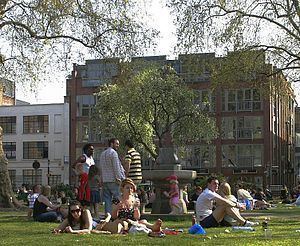 | ||
Hoxton square
Hoxton Square is a garden square situated in Hoxton in the London Borough of Hackney, in London's East End. Laid out in 1683, it is thought to be one of the oldest squares in London. At one time home to industrial premises, since the 1990s it has become the heart of the Hoxton arts and media scene, as well as being a hub of the thriving local entertainment district. Since the year 2000 the square's buildings, largely of Victorian vintage, have become host to a variety of bars, restaurants and clubs.
Contents
History
Hoxton Square was laid out by Samuel Blewitt and Robert Hackshaw, who leased the land from the Austen family in 1683.
Hoxton and Charles Squares, as well as being fashionable neighbourhoods, were centres of non-conformist sects. From 1699 to 1729 an Academy, offering a wide curriculum and also allowing "free enquiry" by its students, was situated in the square. Samuel Pike, who lived in a house in the square, offered theological teaching from 1750. Samuel Morton Savage opened his Hoxton Square Academy there. The Academy closed in 1785.
Hoxton Square is home to the Augustinian Priory, church and school of St Monica (architect: E. W. Pugin) built 1864-66 and the first Augustinian House in England since the Reformation era.
Culture
At one time home to industrial premises, since the 1990s it has become the heart of the Hoxton arts and media scene, as well as being a hub of the thriving local entertainment district. Since the year 2000 the square's buildings, largely of Victorian vintage, have become host to a variety of bars, restaurants and clubs. The square contains art galleries, restaurants, bars and pubs, and is home to Sh! Women's Erotic Emporium. The south side of the square was home to the White Cube art gallery until 2012, known for representing a number of the movement of Young British Artists.
Notable people
The Christian theologian John Thomas, founder of the Christadelphian movement, was born at Hoxton Square in 1805, and in 1810 the square was home to Peter Durand, who filed the first English patent for the tinning of food.
One of Hoxton Square's 18th-century residents, the Reverend John Newton, composed the popular hymn "Amazing Grace". The parish church of St John's Hoxton is nearby, where one of Prince George of Cambridge's ancestors was married in the mid-19th century.
James Parkinson (1755–1824), the physician and author of An Essay on the Shaking Palsy, the subject of which is now known as Parkinson's disease, was in practice at 1 Hoxton Square, which is commemorated with a blue plaque on the site.
